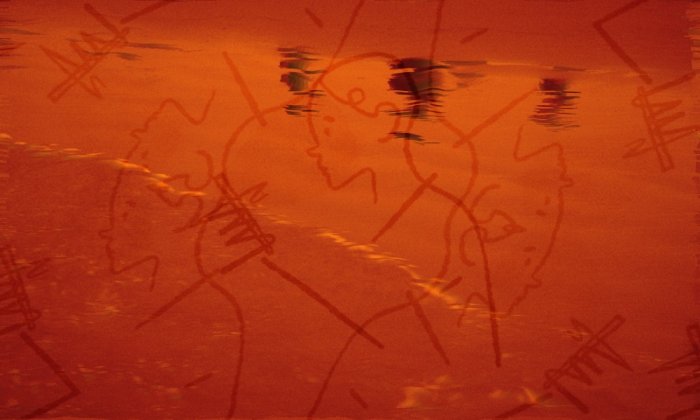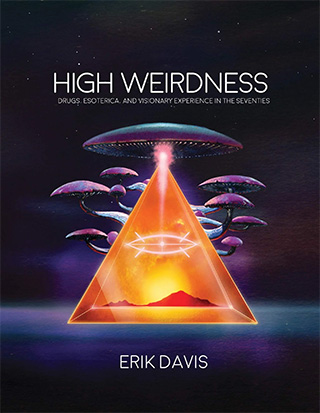An Apocalyptic Meditation on Doomscrolling

As far as I can make out, the term “doomscrolling” started making the rounds in 2019, and became, for obvious reasons, far more infectious in 2020. We’ve had two more years of pandemic, and a yearish of whatever this next thing we are in is, and the term does not seem to be losing much luster. I still hear and use it, partly because, unlike many hashtag terms, it refers to an actual practice, or mode of behavior, or mind-wrecking compulsion, in which guise it remains a significant feature of many people’s lives, including my own.

I suspect you know it well: Whether over breakfast or on the metro or during a procrastination break at work, you dip into your newsfeed, which is largely distressing of course, but you keep at it, heading deeper into the gloom. You might start out with some of that old-school newspaper-reader attitude, a mix of curiosity and responsibility and self-concern, under which lies a more basic and unspoken mimetic impulse to keep up with the pressing narratives of a group, a region, a nation, a species. But then the bottom drops out, and the feed starts to feed on you. The number, scale, and wickedness of the problems served up by crisis media — wicked not only in the sense of being nasty and often nefarious, but of being hairy beyond all possible resolve, and therefore ripe for dissension — rears up like, well, a wicked monster, consuming hope, potential, and whatever modicum of feel-good you started your sesh with. And if you are additionally gobbling up spicy social media takes on said problems — something that is not habitual for me — well, my heart goes out to you.
We never begin the day doomscrolling. We are reading or researching, and then doomscrolling takes over, an uncanny transition from worried and even obsessive concern to hopeless dread and apocalyptic nausea. It’s that moment when, rather than turn from the proximate source of your stress — maybe switch to a novel or find your eternal center of timeless awareness or call your mom — you neurotically and addictively cling to the invading infoswarm of present and likely horrors, chain-smoking the grim tidings like they were butts picked from the gutter. What was once news of the world, consumed with the thoughtful if sometimes enraged concern of the citizen, metamorphs into one of those classic psychoanalytic objects of ambivalence: an amorphous and sickly nightmare Thing that simultaneously fascinates, compels, disgusts, frightens, and destroys. The more you try and get to the bottom of it, the more it sucks you under.
Compulsion is key to doomscrolling, which means that, whatever else is going on, we enjoy it.
You might have noticed my charged language here — wicked, monster, horrors, nightmare — but all of it pales to the noun honored in the neologism that started us off: doom. Or rather, DOOM. It’s not exactly an everyday word. People sometimes casually drop the adjective — a doomed attempt, doomed from the start — but the noun is much rarer, at least outside of Marvel supervillains, or heavy metal, or old-school first-person shooters — in other words, outside the shadowy margins of genre. But this connection to dark fantasy, horror, and religious myth is, I would argue, absolutely key to the stickiness of the doomscrolling tag and, more importantly, to our susceptibility to the practice it names.
Compulsion is key to doomscrolling, which means that, whatever else is going on, we enjoy it. I suspect everyone has their own twist on this enjoyment, which has less to do with simple pleasure than with jouissance, the Lacanian idea of pleasure confused with pain or intensity, memorably defined in Seminar XVII as the tickle that ends “in a blaze of petrol.” What I want to do here is to approach that pleasure through the lens of genre and narrative. In this sense, doomscrolling — in contrast to “getting depressed by the news” — names a mythic or phantasmic supplement to our data-driven distress, a gothic dystopian nightmare excess drawn from the inky well of Story that stains and weirdly sweetens both our news and the way we digest it.
But it’s not just any over-the-top gothic dystopian nightmare excess. It’s DOOM, a word heavier than fate, more horrible than disaster, more gnarly and heathen than apocalypse. Just listen to some doom metal. Etymologically and otherwise, doom is not just a bummer but a last judgment — a final determination, a binding decree, a closing verdict that actively condemns, or reveals, the state of things. Doom is not just rendered — it is written or announced, and therefore read or heard in advance. The titular threat in Lovecraft’s Dunsanyesque tale “The Doom that Came to Sarnath” is actually the word DOOM itself, inscribed on an altar by a dying priest who foreordains, or perhaps only prophesies, the eventual destruction of the city.
That doom is frequently inscribed, reminding us of another dread resonance lurking in our neologism. For what is a doom written on if not a scroll? As a verb, digital “scrolling” is not quite a skeuomorph, but something close: the resurrection of an anachronistic media practice inside a contemporary one. But it’s the noun that holds the prophetic gravitas here. The Revelation of Saint John is awash with scrolls, including the famous one with seven seals, which unleashes the end-times brigade. The cosmos itself becomes a scroll in the book’s sixth chapter, with the sky receding “as a scroll when it is rolled up, and every mountain and island was moved out of its place.” Still later, an angel brings John a “little scroll” — with 5G hopefully — that he is commanded to eat — that is, to consume. He tells us it tastes sweet at first, and then sickens him with bitterness. Another blaze of petrol.

Doom does not always imply a cosmic barrister or prophet; sometimes the laws of physics are enough to foreordain an implacable fate. Doom is spoken, but doom also comes down, a thing of gravity we see heading toward us miles away, like the unavoidable death of our sun. So while you could just as easily call doomscrolling something like dreadscrolling, which better describes the actual feeling, doom names three additional features beyond dread: foreknowledge, finality, and inevitability. Whether it be the sentence of a pitiless cosmic barrister or the workings of karma, just deserts are on their way.
Most of us do not believe we are doomed most of the time. Even if we consider the enormity of the problems unfolding across the globe, we often hold to the idea that “we” are at fault, or possibly “they.” This means there is still something we can do about it. Even in the case of climate crisis — where a myriad of ships have long ago set sail, and the chickens coming home to roost are barbed and ferocious — the complex causes and dynamics at play get reduced in our imagination to human responsibility, and particularly to behaviors that can still be changed. Even if we blame corporations or globalist cabals, powers far beyond our meager levers, we still do not let humans off the hook. Choices and actions are still on the table.
Doom is spoken, but doom also comes down, a thing of gravity we see heading toward us miles away, like the unavoidable death of our sun.
In this situation, doomscrolling becomes a kind of edge-play with agency itself, both personal and collective. By feasting on more and more terrible news, we unravel whatever threadbare hopes remain, tipping ourselves into the ever-present abyss of hopelessness and fatalistic despair. But here’s the secret: Because so many of us feel guilty, painfully aware of our complicity in the trainwreck, doomscrolling’s descent into abject surrender offers its own hidden relief. We may remain fascinated with the intricacies of the car crash, but there is really nothing we can do about it. In our darker (or more realistic) hours, we may reason our way to such hopelessness — pessimism of the intellect, and all that — but the emotional submission is where the real frisson lies, the horror and, to be frank, the temporary release, or the sadomasochistic fantasy of release.
But who is the top in this scenario? Within the fantasy that drives doomscrolling, we may imagine that we are finally submitting to Reality, to the hard fact of a world collapsing like dominoes. But we are really bending down before our feeds. In this game, media is the Master.
On one level this is just stating the obvious. We all know that, left or right, “the media” gain from our dread and anxiety, that fear sells, that YouTube algos suck us into feverish extremes, that infinite scroll opens up what Hegel called “bad infinity.” But there is something deeper afoot, something about the mediation offered by narrative itself, or, more accurately, the intensification of narrative affect, the tendency of our storytelling to drift toward sensation.
As I rabbit-holed into doomscrolling, I stumbled upon a 2018 Futurity.org piece about a study in Risk Analysis that analyzed “the impact of dread on the social amplification of threat.” The study tracked the evolution of negative news stories as they passed through a chain of social media participants who did not have access to the original report. Over and over, this online game of telephone intensified the threat and thickened the telling with panic. Moreover, in the face of this “contagion of fear,” the re-injection of the original, less extreme data had virtually no effect on reducing people’s anxiety.
As I wrote above, we ramp stuff up because on some level we enjoy this shit. In the narratives we tell about the world around us, we get very excited about scenarios that are turbo-charged with onrushing threat. In other words, the dark compulsion that drives doomscrolling is partly a mode of our own imagination, but an imagination driven towards certain intensities. Sensationalism is built on sensation after all. Thrills and spills, Romanticism’s swoon of despair, the confrontation with the abyss or God’s plan. But now the possibility of all these feelies is stitched into the Real.
In that sense, doomscrolling is a way of “weirding” crisis media in order to secretly, unconsciously transform it into a subgenre of horror — a subgenre whose emotional effectiveness requires that we disavow the fantasies that partly drive it, a disavowal we effect by insisting on the reality of the data and the rationality of the fear and hopelessness it engenders. “I’m not indulging in fear, I am facing reality.” Note of course, that this dalliance with the Real has been part of horror’s game all along, from Kenneth Grant’s left-hand Lovecraft to heavy metal evil (“are they really Satanists?”) to “based on a true story” potboilers to “The Blair Witch Project” to creepypasta and Slender Man. The devil’s greatest trick is to convince us that he does not exist, but horror’s greatest trick is to convince us that its fabulations do.
Let me be clear: I am not saying that our narratives of existential threat, or social media signs of social collapse, are simply fictions. That would be stupid and insane. When we doomscroll, most of us (at least among the “us” likely to read this) are still participating in the lingering Enlightenment commitment to argument, evidence, clarity, and can-do agency, the rickety matrix that undergirds public discourse and the whole idea of “news.” We are absorbing more or less accurate information about the concrete material and historical conditions of the contemporary world — although those conditions now centrally include ferociously mediated narrative conflict that actively invokes and deploys all manner of fictions, phantasms, and genre plots.
The point about doomscrolling, though, is that the quality of the information doesn’t matter. Sooner or later, as we feed on our feed, even the most clear-eyed and rational among us slips gears, a psychomagical ka-chunk that resounds like an ancient hammer blow or a crypt door in a vampire flick: BOOM. DOOM. At that moment, we are thrust beyond the Enlightenment’s circle of illumination, facing an inner dread and an outer darkness that only myth or religion or cosmic horror can limn. And we got there not by closing our eyes to the deepening fractures in the world, but in seeing those cracks with more and more detail until a kind of vertigo seizes hold. As we tune into the little abysses now gouging the concrete world — in ecological systems, AI regulation, supply chains, mental health, political processes — those little abysses start to stare back. As I wrote long ago in Techgnosis, it’s not the sleep of reason that breeds our monsters, but reason with its eyes agog.
Do not mistake any of this as a counsel of despair. Doomscrolling is a reminder, again to allude to my first book, that our everyday factual lives are woven into an uncanny and psychopathological tapestry of myth, narrative magic, and the mysticism of ultimate things — ultimate ends, ultimate voids, death writ large. But it’s also true that the emotional poverty and insufficiency of social media and newsfeeds is revealed with stark abyssal clarity, and so equally clarifies the need to turn around and claw our way back to the world, to some sense of duration and depth. Reason and investigation are part of that process, but so too is a wiser engagement with our shadow selves. And one way to do that is to recognize and take responsibility for the stories and “affective intensities” swallowing us up.
Doomscrolling is a reminder that our everyday factual lives are woven into an uncanny and psychopathological tapestry of myth, narrative magic, and the mysticism of ultimate things.
What fiction is riding you? In Jung’s terms, those spelunking the deep self need to be wary of being “captured by the archetype,” a capture that is signaled everywhere these days by the “passionate intensity” evidenced in so many mediated voices, an intensity William Butler Yeats pegged a century ago in “The Second Coming” as a particularly terrible temptation in apocalyptic times. Not being captured by an archetype doesn’t mean avoiding them, however, for that is not possible. Scientists and skeptics too can be ridden by Story. So not being captured means owning up to the presence of these forces: bringing them to consciousness, comprehending their character, and forming sometimes wary alliances with them.
If archetype is too loaded a word for you, you can think instead of genre. We need and enjoy our genres of storytelling, which help us organize the diversity of the stories we rely on. But don’t be captured by any of these genres. Please don’t let your relationship get organized by rom-coms, or your work life inspired by heroic action movies, or your spiritual life deluded by fantasy. And the next time you catch yourself doomscrolling, take it as an invitation to own your own horror. Get to know this most mortal, most religious, and most repulsively embodied of genres. Even if you are not a fan.
The film critic Robin Wood defined the basic horror plot as “normality is threatened by the monster.” Well the monster is here, oh you pretty things, and it looks as though it’s here to stay. Might as well make room for the holy peculiar.
Erik Davis is the author of several books, including “High Weirdness: Drugs, Esoterica and Visionary Experience in the Seventies” and “TechGnosis: Myth, Magic and Mysticism in the Age of Information,” and writes the newsletter Burning Shore, where this article first appeared.



